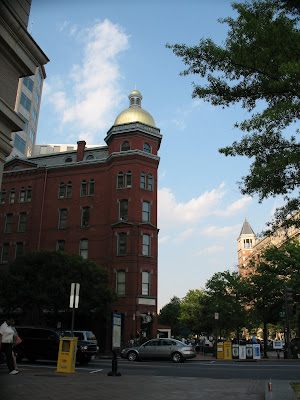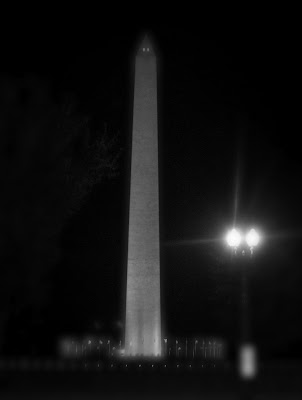Saturday, June 30, 2007
Fireman's Fund
Built in 1882, the Fireman's Fund Building at the corner of 7th Street and Indiana Avenue NW was originally the office for the Fireman's Fund Insurance Company in Washington, D.C. Founded in 1863 in San Francisco, the FFIC was thusly "named for an arrangement in which [the Fund] paid 10 percent of [its] profits to widows and orphans of firefighters"--a mandate that continues to this day.
The Firemen's Fund has been an integral player in some of America's most noteworthy events and construction achievements, including paying all claims from the Chicago and Boston fires; rebuilding Virginia City, Nevada, after fire destroy three-quarters of the town; insuring "horseless carriages;" insuring movie studios against the risk of producing "talkies;" and underwriting construction of the Golden Gate Bridge, as well as paying out claims on disasters ranging from 9/11 to Hurricane Katrina.
The building is located at 325 Seventh Street NW and is part of a larger commercial space that includes a 12-story office building. The building's tenants include Starbucks, the U.S. Department of Justice, the American Hospital Association, and the National Retail Federation.
Photo copyright: D.C. Confidential (Janet M. Kincaid, 06/07)
El Gato
Wednesday, June 27, 2007
Protesting Bed Bugs

On my way into work this morning, I passed this protest taking place at the corner of 9th Streets and Rhode Island Avenue NW. Seems the building, which you can't see, but which is behind these folks, is infested with all manner of vermin and pestilence. I took the picture more because it illustrates two of America's freedoms: the right to petition and the right to assemble (U.S. Bill of Rights, Article I.) I hope they achieved their outcome.
Photo copyright: D.C. Confidential (Janet M. Kincaid, 06/07)
Saturday, June 23, 2007
diminutive
On my commute every morning, I pass this car on my way to work. Remember these?
It's a Fiat and it always puts a smile on my face when I see it. It's smaller than a Mini Cooper and everytime I pass it, I expect a clown to pop out. I don't know what kind of gas mileage it gets, but no doubt it never lacks for a parking space. A couple of weeks ago, I thought it was gone. Then I discovered it wedged between two gargantuan pick-up trucks. It sort of looked like this:
BIG TRUCK little car BIG TRUCK
Zip: 20012
Zip: 20012
Photo copyright: D.C. Confidential (Janet M. Kincaid, 06/07)
Towering
Located on the back lot of the Metropolitan Police Department's (MPD) Fourth District (4D) precinct is this radio dispatch tower. I refer to it as the Eiffel Tower of D.C. It stands on the District's second highest point in the city and provides radio dispatch coverage to D.C.'s first responders. Up close, it's not that striking, but from a distance, it can be rather pretty.
Photo copyright: D.C. Confidential (Janet M. Kincaid, 06/07)
Friday, June 22, 2007
Monumental
Located in the center of the National Mall, the Washington Monument is the memorial that was constructed to pay homage to America's first president, George Washington. Standing at 555 feet, the monument is constructed of marble, granite and sandstone. Designed by architect Robert Mills, the monument took 36 years to build and cost $1 million. Construction began in 1848 and was completed in 1884. At the time of its completion, it was the world's tallest structure--a distinction it held until 1889, when the Eiffel Tower was completed in Paris.
The original design was meant to include a pantheon, but construction was repeatedly delayed--the result of a continual lack of funds and the Civil War. If you look closely at the monument, you can see the obelisk was built in five stages as the marble was cut at different periods during the construction resulting in inconsistent shades. It is particularly easy to see the gradations after a rain storm.
The Washington Monument is surrounded by 50 flags representing each of the states in the union. It is open to the public year-round except on July 4th and Christmas Day. Admission is free but you must obtain timed-tickets from the ticket booth located at 15th Street and Independence Avenue SW (down the terraced hillside to the northeast of the monument.)
Photo copyright: D.C. Confidential (Janet M. Kincaid, 06/07)
Friday, June 8, 2007
Beep Beep
I was testing the video feature of my Canon A630 camera and was able to capture this image while driving at 9:30 at night through the tunnel that runs under the National Zoo on Beach Drive.
If you live in the city for a long time, you learn how to bypass the majority of congestion and legions of traffic lights by taking roads like North Capitol Street, Missouri Avenue/Military Road, and Rock Creek Parkway.(1) The parkway commences just to south of the The John F. Kennedy Center for the Performing Arts and takes you past the Watergate and Georgetown, through the center of the city without hitting a single stop light until you either peel off to the left for Connecticut Avenue or you peel off to the right and onto Beach Drive. Even then, you're not going to hit a light or stop sign until you get to the split for Piney Branch and Beach Drive.
Rock Creek Parkway(2) is a great way to get from the National Mall in the south end of the city all the way up into Maryland on the north end. (Beach Drive actually hooks a left at Stoneybrook Drive, which is where the Mormon Temple is in Kensington, Maryland, and continues through Maryland into Rockville.)
On the weekends, the National Park Service--the agency that has jurisdiction for Rock Creek Parkway--closes a stretch of the parkway from Blagden Avenue in D.C. all the way to the Maryland line so bikers and runners can engage in their physical activity without the risk of being run down by a car. The rest of the week, it's a major commute thoroughfare that includes one-way lane changes during rush hour with all lanes going south in the morning and then reversing in the evening and going north. As soon as my camera comes back from the shop, I'll take and post better pictures of this sanity-saving segue.
Photo copyright: D.C. Confidential (Janet M. Kincaid, 06/07)
1. Link to National Park Service site.
2. Link to Wikipedia.
Labels:
In the City Limits,
Locale-Rock Creek,
Quadrant-NW
Tuesday, June 5, 2007
Ahoy
Situated in the plaza right outside my office building is the United States Navy Memorial. The memorial's purpose is to "honor the men and women of the Sea Services--past, present, and future." Commissioned in 1980, construction began in 1985 as part of a revitalization of Pennsylvania Avenue--America's Main Street. The memorial was completed in 1987--the 212th anniversary of the Navy in the United States.
The memorial features a plaza with a map of the world, 26 bas reliefs depicting various scenes from Navy, Marine, Coast Guard, and merchant marine life, fountains, and masts. The center point of the memorial is a statue called "The Lone Sailor." The memorial is on the north side of Pennsylvania Avenue with the National Archives on the south. This photo features part of the fountain features in the foreground and the archives in the background.
Photo copyright: D.C. Confidential (Janet M. Kincaid, 06/07)
Saturday, June 2, 2007
Atypical

Most of the architecture you find in homes in the D.C. area is largely influenced by early European architecture. Compared to other parts of the country, it's heavily traditional. Mostly Federal, Georgian, early Colonial, New England, some French Provincial--loaded with brick and columns and porticos and high ceilings and trim, etc.
Occasionally, though, you run across a home in this area that defies the traditional norm. A case in point is this home. Located in Takoma Park, just off of Sligo Creek Parkway, it features cinder block construction with large windows and abundant open space. As a friend of mine said the other day, "It looks like it belongs in Marin County, California, or somewhere on the West Coast. I wonder if it's lost?"
Photo copyright: D.C. Confidential (Janet M. Kincaid, 06/01)
Subscribe to:
Comments (Atom)



















